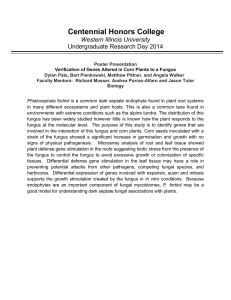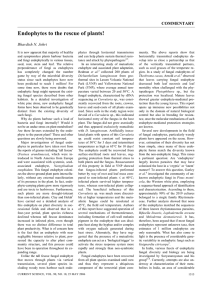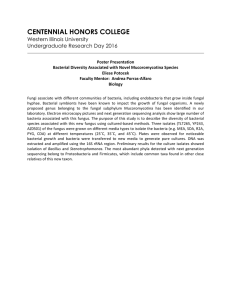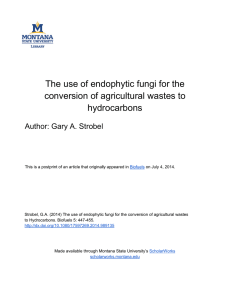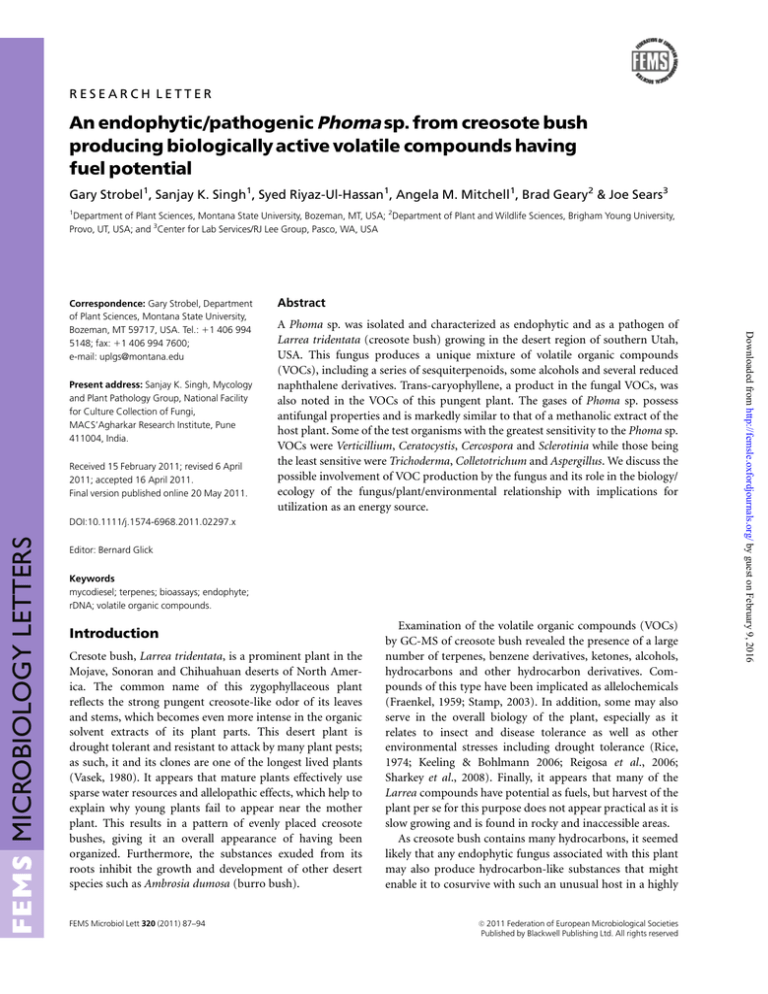
RESEARCH LETTER
An endophytic/pathogenic Phoma sp. from creosote bush
producing biologically active volatile compounds having
fuel potential
Gary Strobel1, Sanjay K. Singh1, Syed Riyaz-Ul-Hassan1, Angela M. Mitchell1, Brad Geary2 & Joe Sears3
1
Department of Plant Sciences, Montana State University, Bozeman, MT, USA; 2Department of Plant and Wildlife Sciences, Brigham Young University,
Provo, UT, USA; and 3Center for Lab Services/RJ Lee Group, Pasco, WA, USA
Present address: Sanjay K. Singh, Mycology
and Plant Pathology Group, National Facility
for Culture Collection of Fungi,
MACS’Agharkar Research Institute, Pune
411004, India.
Received 15 February 2011; revised 6 April
2011; accepted 16 April 2011.
Final version published online 20 May 2011.
Abstract
A Phoma sp. was isolated and characterized as endophytic and as a pathogen of
Larrea tridentata (creosote bush) growing in the desert region of southern Utah,
USA. This fungus produces a unique mixture of volatile organic compounds
(VOCs), including a series of sesquiterpenoids, some alcohols and several reduced
naphthalene derivatives. Trans-caryophyllene, a product in the fungal VOCs, was
also noted in the VOCs of this pungent plant. The gases of Phoma sp. possess
antifungal properties and is markedly similar to that of a methanolic extract of the
host plant. Some of the test organisms with the greatest sensitivity to the Phoma sp.
VOCs were Verticillium, Ceratocystis, Cercospora and Sclerotinia while those being
the least sensitive were Trichoderma, Colletotrichum and Aspergillus. We discuss the
possible involvement of VOC production by the fungus and its role in the biology/
ecology of the fungus/plant/environmental relationship with implications for
utilization as an energy source.
MICROBIOLOGY LETTERS
DOI:10.1111/j.1574-6968.2011.02297.x
Editor: Bernard Glick
Keywords
mycodiesel; terpenes; bioassays; endophyte;
rDNA; volatile organic compounds.
Introduction
Cresote bush, Larrea tridentata, is a prominent plant in the
Mojave, Sonoran and Chihuahuan deserts of North America. The common name of this zygophyllaceous plant
reflects the strong pungent creosote-like odor of its leaves
and stems, which becomes even more intense in the organic
solvent extracts of its plant parts. This desert plant is
drought tolerant and resistant to attack by many plant pests;
as such, it and its clones are one of the longest lived plants
(Vasek, 1980). It appears that mature plants effectively use
sparse water resources and allelopathic effects, which help to
explain why young plants fail to appear near the mother
plant. This results in a pattern of evenly placed creosote
bushes, giving it an overall appearance of having been
organized. Furthermore, the substances exuded from its
roots inhibit the growth and development of other desert
species such as Ambrosia dumosa (burro bush).
FEMS Microbiol Lett 320 (2011) 87–94
Examination of the volatile organic compounds (VOCs)
by GC-MS of creosote bush revealed the presence of a large
number of terpenes, benzene derivatives, ketones, alcohols,
hydrocarbons and other hydrocarbon derivatives. Compounds of this type have been implicated as allelochemicals
(Fraenkel, 1959; Stamp, 2003). In addition, some may also
serve in the overall biology of the plant, especially as it
relates to insect and disease tolerance as well as other
environmental stresses including drought tolerance (Rice,
1974; Keeling & Bohlmann 2006; Reigosa et al., 2006;
Sharkey et al., 2008). Finally, it appears that many of the
Larrea compounds have potential as fuels, but harvest of the
plant per se for this purpose does not appear practical as it is
slow growing and is found in rocky and inaccessible areas.
As creosote bush contains many hydrocarbons, it seemed
likely that any endophytic fungus associated with this plant
may also produce hydrocarbon-like substances that might
enable it to cosurvive with such an unusual host in a highly
2011 Federation of European Microbiological Societies
Published by Blackwell Publishing Ltd. All rights reserved
c
Downloaded from http://femsle.oxfordjournals.org/ by guest on February 9, 2016
Correspondence: Gary Strobel, Department
of Plant Sciences, Montana State University,
Bozeman, MT 59717, USA. Tel.: 11 406 994
5148; fax: 11 406 994 7600;
e-mail: uplgs@montana.edu
88
stressful environment. Thus, the main aim of this study was
to determine if any endophytes of creosote bush do exist and
if they produce hydrocarbon-like substances that have
biological activity and possible potential as fuels. Thus, the
rationale for the approach of finding an endophyte-making
product similar or identical to its host plant follows the logic
relating to an earlier study in which fungal taxol was
discovered as a product of an endophytic fungus living in
association with Pacific yew, Taxus brevifolia, a producer of
taxol (Stierle et al., 1993).
We describe the successful recovery of a novel pathogen/
endophyte of L. tridentata and demonstrate that it produces
a plethora of hydrocarbons and hydrocarbon derivatives not
only possessing biological activity, but also having potential
as a biofuel – MycodeiselTM (Strobel et al., 2008).
Fungal isolation and storage
Fungal culture Ut-1 was obtained as an endophyte from a
small plant of L. tridentata. Tissue samples were excised
from several plants growing south of St. George, UT, at
37103 0 067200 N, 113133 0 105400 W. Isolation procedures followed a previously described protocol (Ezra et al., 2004).
Briefly, external tissues were thoroughly exposed to 70%
ethanol before excision of internal tissues, which were
cultured on standard Petri dishes of water agar. Endophytic
fungi growing from the plant tissues were then picked and
recultured on potato dextrose agar (PDA). The fungus was
stored by placing colonized sterile barley seed, which was
subsequently air dried, and then stored at –70 1C. The
fungus has been deposited in the living Montana State
University mycological collection under acquisition number
2378.
Internal transcribed spacer (ITS)-based
phylogenetic analysis
Phylogenetic analysis of the fungal strain was carried out by
acquisition of the ITS 5.8S ribosomal gene sequence. The
fungus was grown on PDA for 7 days and DNA templates
were prepared by using the Prepman Ultra Sample Preparation Reagent (Applied Biosystems) according to the manufacturer’s guidelines. The ITS regions of the fungus were
amplified with the universal ITS primers ITS1 (5 0 TCCGTA
GGTGAACCTGCGG 3 0 ) and ITS4 (5 0 TCCTCCGCTTATT
GATATGC 3 0 ) using PCR. The PCR conditions used were as
follows: initial denaturation at 94 1C for 3 min followed by
30 cycles of 94 1C for 15 s, 50 1C for 30 s and 72 1C for 45 s,
and a final extension of 72 1C for 5 min. The 50-mL reaction
mixture contained 1 PCR buffer, 200 mM each dNTP,
1.5 mM MgCl2, 10 pmol of each primer, 1–5 ng of DNA and
2.5 U of Taq DNA polymerase. The amplified product (5 mL)
2011 Federation of European Microbiological Societies
Published by Blackwell Publishing Ltd. All rights reserved
c
was visualized on 1% (w/v) agarose gel to confirm the
presence of a single amplified band. The amplified products
were purified by Amicon Ultra columns (Millipore) and
40–60 ng was used in a 10 mL sequencing reaction using the
Big Dye Terminator sequencing kit (v. 3.1). The forward or
the reverse primer (3.2 pmol) was used in the cycle sequencing reaction. Twenty cycles of 96 1C for 10 s, 50 1C for 5 s
and 60 1C for 4 min were performed and the extension
products were purified by ethanol precipitation, dissolved
in 15 mL of HiDi formamide, incubated at 95 1C for 1 min
and loaded on an ABI Prism 377 Genetic Analyzer (PerkinElmer) for sequencing. All the reagents for sequencing were
from Applied Biosystems. The amplified products were
sequenced and aligned with the sequences in the GenBank
database via the BLASTN program (Altschul et al., 1997).
Relevant sequences were downloaded and aligned using the
MEGALIGN program (DNASTAR, Lasergene) and a phylogenetic tree and distance matrix were constructed according to
Guindon & Gascuel (2003).
Scanning electron microscopy (SEM)
SEM was performed on sterile carnation leaves colonized
with CI-4 according to the following protocol outlined by
Ezra et al. (2004). These leaves promoted the production of
fungal fruiting structures as they have been sterilized by
gamma irradiation. The fungus was grown on carnation
leaves for several weeks and then was processed for SEM.
The samples were slowly dehydrated in ethanol and then
critically point dried, coated with gold and examined with
an FEI XL30 scanning electron microscope field emission
gun at 5 kV at high-vacuum mode using an EverhartThornley detector . A gaseous secondary electron detector
was used with a spot size of 3, at 15 kV. The temperature was
4 1C with a chamber pressure which ranged from 5 to 6 T,
providing humidity up to 100% at the sample.
Bioassay tests for Hypoxylon sp. VOCs
against pathogens
The VOCs produced by Ut-1 were tested for inhibitory
antimicrobial activity against selected pathogenic fungi
according to a bioassay test system described previously for
analysis of VOCs produced by Muscodor albus (Strobel et al.,
2001; Tomsheck et al., 2010). The assays were conducted by
removing a 2.5-cm-wide strip of agar from the mid-portion
of a standard Petri plate of PDA, creating two isolated halves
of agar. The fungus was inoculated onto one semi-circular
agar piece and incubated at 23 1C for 10 days to allow for
optimum production of volatile compounds. Test pathogens
were inoculated onto the semi-circular section of agar
opposite the semi-circular section inoculated with Ut-1.
The plate was then wrapped with a single piece of parafilm
FEMS Microbiol Lett 320 (2011) 87–94
Downloaded from http://femsle.oxfordjournals.org/ by guest on February 9, 2016
Materials and methods
G. Strobel et al.
89
Endophytic Phoma sp. and its VOCs
and incubated at 23 1C for 24 h. Growth of filamentous
fungi was quantitatively assessed based on multiple measurements of growth extending from the edge of the
inoculum plugs comparable with corresponding controls as
described by Strobel et al. (2001). All tests were conducted in
triplicate.
Qualitative analyses of fungal VOCs
Preparation of L. tridentata extracts
Leaves and leaf fragments of 1.0 g of freshly harvested plant
material was thoroughly ground with a mortar and pestle in
40 mL methanol. The methanolic solution was decanted and
passed through four layers of cheesecloth to remove plant
FEMS Microbiol Lett 320 (2011) 87–94
Koch’s postulates on Ut-1
A number of creosote plants were selected and transplanted
to the Montana State University greenhouse facility. Inoculation of leaves was accomplished by making two to three
pin pricks through each of many leaf blades and then
flooding the surface with a suspension of 107 spores mL1.
Uninoculated leaves were treated in the same manner, but
without the introduction of the spore suspension. The leaves
were held at 23 1C in 100% relative humidity for 5–7 days
and then evaluated for symptom production. Re-isolation of
the putative pathogen was accomplised in the same manner
as described above for fungal isolation and recovered fungi
were evaluated based on cultural and morphological characters.
Results
Over the course of a number of years several sites in the
southern deserts of Utah were sampled in May and June for
endophytic microorganisms associated with L. tridentata,
but with no success. In midwinter, the roots, stems and
leaves of a number of bushes were sampled in an area south
of St. George, UT, and only one fungal endophyte, and no
other microorganism, appeared in the root specimens of the
symptomless plants that had been sampled. In early spring,
close examination of the leaves of many creosote bushes in
this area revealed that they were showing disease symptoms,
i.e. small necrotic spots having one or more black pustulelike fruiting stuctures (pycnidia) associated with each lesion.
From these diseased areas of the leaves it was possible to
isolate the same fungus that had been isolated from the
symptomless roots of this plant species. Interestingly, cultures of this fungus were odoriferous but not in the same
manner as that of the host plant.
The fungus in each case possessed the following cultural
and morphological characteristics.
Colonies on PDA are 50–55 mm after 8 days at 23 1C,
olivaceous to greenish olivaceous, forming concentric rings,
later turning completely black due to formation of pycnidia;
aerial mycelium is almost absent, margin is regular and
reverse concolorous. Conidiomata are pycnidial, solitary
(sub-)globose to broadly ellipsoidal, glabrous or with some
hyphal outgrows, on the agar surface and immersed, later
forming concentric rings, 120–200 113–145 mm. Ostioles
(one to three) are nonpapillate sometimes slightly papillate,
circular to oval and 20–25 mm in diameter. The pycnidial
wall is pseudoparenchymatous, composed of angular cells
and comprises two to four layers. Conidiogenous cells are
phialidic, simple, smooth-walled, hyaline, flask-shaped and
somewhat isodiametric. Conidia are ellipsoidal to ovoid or
2011 Federation of European Microbiological Societies
Published by Blackwell Publishing Ltd. All rights reserved
c
Downloaded from http://femsle.oxfordjournals.org/ by guest on February 9, 2016
Analysis of gases in the air space above the culture grown for
12 days at 23 2 1C on PDA was undertaken using the solid
phase microextraction fiber technique (Strobel et al., 2001).
First, a baked ‘Solid Phase Micro Extraction’ syringe (Supelco) consisting of 50/30 divinylbenzene/carburen on polydimethylsiloxane on a stable flex fiber was placed through a
small hole drilled in the side of the Petri plate and exposed to
the vapor phase for 45 min. The syringe was then inserted
into the splitless injection port of a Hewlett Packard 6890
gas chromatograph containing a 30 m 0.25 mm inner
diameter ZB Wax capillary column with a film thickness of
0.50 mm. The column was programmed as follows: 30 1C for
2 min followed by and increase to 220 1C at 5 1C min1. The
carrier gas was ultrahigh-purity helium (local distributor)
and the initial column head pressure was 50 kPa. Before
trapping the volatiles, the fiber was conditioned at 240 1C
for 20 min under a flow of helium gas. A 30-s injection time
was used to introduce the sample fiber into the chromatograph. The gas chromatograph was interfaced to a Hewlett
Packard 5973 mass-selective detector (mass spectrometer)
operating at unit resolution. The spectrometer was scanned
at 2.5 scans s1 over a mass range of 35–360 a.m.u. Data
acquisition and data processing were performed on the
Hewlett Packard CHEMSTATION software system. Initial identification of the compounds produced by the endophyte was
made via library comparison using the National Institute of
Standards and Technology (NIST) database, and all chemical compounds described in this report use the NIST
database chemical terminology. As far as possible, authenticity of each compound identified by GC/MS was reconfirmed by GC/MS of authentic standards. Standard
compounds were obtained from Sigma-Aldrich and run in
a comparable manner as the fungal samples. Compounds
that were not identified on the basis of a match to an
authentic standard were tentatively identified (listed) when
they yielded a quality score of 60 or better. The experiments
were repeated at least twice.
particles. The solution was taken to dryness by flash
evaporation at 37 1C and the residue was stored at 20 1C.
90
G. Strobel et al.
Fig. 2. Phylogenetic position of Phoma sp. Ut-1
(Guindon & Gascuel, 2003). Numbers designate
branch support values.
subcylindrical, thin and smooth-walled, hyaline, aseptate to
septate, extremely variable in size [(5) 5.5–9.5 (10) mm
(x = 7.05, SD = 1.18, n = 30) (3) 3.5–4.5 (5) mm (x = 4.26,
SD = 0.64, n = 30)] and rarely guttulate (Fig. 1).
Collectively, these morphological features strongly support the placement of the present isolate as a species of
Phoma Sacc. emend. Boerema & G.J. Bollen (Fig. 1).
Furthermore, ITS sequence data showed that the endophyte
is a strain of the genus Phoma (Fig. 2). The ITS 5.8S
ribosomal gene showed a maximum homology of 99.2%
with Phoma herbarum strain BLE15 and Phoma sp. strain
11360. The endophyte also exhibited 99% sequence homology with Phoma medicaginis strain CBS 533, Phoma macrostoma, Ascochyta rabiei (Phoma rabiei) strain CBS 237.37
and Didymella phacae CBS strain 184.55, as presented in the
distance matrix chart (Fig. 2).
No Phoma sp. previously has been reported from this
plant either as an endophyte or as a pathogen. The genus
Phoma sp., as typified by P. herbarum (Boerema 1964), is a
complex and heterogeneous assemblage of more than 3000
infrageneric taxa (Monte et al., 1991). It has been considered
2011 Federation of European Microbiological Societies
Published by Blackwell Publishing Ltd. All rights reserved
c
to be one of the largest fungal genera, consisting of taxa
inhabiting soil, organic debris and water, as well as species
that parasitize other fungi, lichens, insects and vertebrates.
In addition, a substantial proportion of the taxa are associated with plant material as primary pathogens. In the case
of isolate Ut-1, it appears that the fungus can exist in the
host plant as both an endophyte and a pathogen under some
circumstances. It was possible to show pathogenicity of the
organism on inoculated leaves of the host, yielding necrotic
spots. Also, subsequently it was possible to successfully
reisolate the causal agent using standard procedures followed by identification of the organism on the basis of its
morphological features (Fig. 1).
Production of VOCs by Phoma sp.
When Phoma sp. was grown on PDA for 10–12 days and
the headspace was examined for VOC content the most
significant observation was that at least 15 compounds
appeared whose mass was 204 and whose chemical assignment was that of a sesquiterpene, with a-humulene (or
FEMS Microbiol Lett 320 (2011) 87–94
Downloaded from http://femsle.oxfordjournals.org/ by guest on February 9, 2016
Fig. 1. Phoma sp. (a) Colony grown on PDA
after 15 days. (b) Scanning electron micrograph
of mature pycnidium with subtending mycelium
developed on PDA. (c) Scanning electron
micrograph of conidia. (d) Scanning electron
micrograph of pycnidial wall consisting of three
to four layers of textura angularis. (e) Mycelial
mat with short conidiophores developed on PDA
as per light microscopy.
91
Endophytic Phoma sp. and its VOCs
Table 1. The VOCs of a 12-day-old culture of Phoma sp. as determined by GC/MS
Compound
2-Butanone
Ethanol
1-Propanol, 2-methylUnknown
1-Butanol, 3-methyl1H-3a, 7-Methanoazulene, 2,3,4,7,8,8a-hexahydro-3,6,8,8-tetramethyl-,[3r(3a,3ab,7b,8aa)]Benzene, 1,3,5-tris (1-methylethyl)b-Chamigrene
Longipinene
trans-Caryophyllene
a-Longipinene
(1)-Aromadendrene
b-Ylangene
Unknown
Unknown
(1)-Aromadendrene
4-(3-Butenyl)-1,2,3,6,7,7a-hexahydro-7a-methyl-5H-inden-5-one
Unknown
Unknown
1-Hexene, 2-(P-anisyl)-4-methylEpi-bicyclosequiphellandrene
1H-Benzocycloheptene, 2,4a,5,6,7,8,9,9a-octahyro-3,5,5-trimethyl-9-methylene,(4as-cis)b-Selinene
d-Guaiene
a-Humulene
a-amorphene
Unknown
b-Himachalene
Cadinene
Naphthalene, 1,2,3,4,4a,7-hexahydro-1,6-dimethyl-4-(1-methylethyl)2,3,4-Trimethyl-4-hydroxy-1,4-dihyronaphthalenone
6,10,11,11-Tetramethyl-tricyclo[6.3.0.1(2,3)]undec-7-ene
Unknown
Naphthalene, 1,2,3,4-tetrahydro-1,6-dimethyl-4-(1-methylethyl)-, (1s-cis)Unknown
Unknown
Benzeneethanol
Naphthalene, decahydro-, cisb-Selinene
Unknown
Unknown
3.191
3.670
6.159
7.789
7.937
10.624
1.02
27.1
1.09
1.14
25.3
59.5
72
83
90
40
78
87
72
46
74
172
88
204
10.866
11.186
11.745
11.925
11.998
12.204
12.380
12.854
12.955
13.079
13.142
13.199
13.467
13.918
14.027
14.126
2.30
1.70
2.65
22.8
13.3
5.05
6.48
1.20
11.2
26.2
3.36
4.08
48.8
18.9
1.72
26.6
58
62
97
72
87
60
86
50
58
91
83
45
49
80
83
99
204
204
204
204
204
204
204
80
204
204
204
161
222
204
204
204
14.230
14.411
14.542
14.629
14.698
14.910
14.936
15.069
15.128
15.426
15.488
16.315
16.374
16.838
17.204
18.689
19.269
21.003
21.186
3.16
15
194
3.18
12.2
3.52
2.49
3.74
6.62
4.24
6.04
1.16
1.83
1.68
1.60
1.37
1.14
1.45
2.37
64
76
91
99
49
99
64
96
83
95
38
96
50
–
95
64
94
46
46
204
204
204
204
204
204
204
204
202
204
181
202
222
–
122
138
204
152
220
Response
The ‘Quality’ column indicates the confidence with which compound identity can be assumed (an asterisk indicates that an authentic standard
compound yielded the same mass data and retention time as the fungal compound). The ‘Response’ column indicates the relative amounts of the
compound detected.
a-caryophyllene) being the most predominant VOC (Table
1). Furthermore, trans-caryophyllene is also present in the
fungal VOC headspace and it too is a major VOC in the
volatiles of L. tridentata (G. Strobel, unpublished data). Also
of interest is the presence of a number of reduced naphthalene derivatives such as those with retention times of 15.06,
15.12, 16.31 and 18.68 min (Table 1). Reduced naphthalene
FEMS Microbiol Lett 320 (2011) 87–94
compounds of this type have been reported from M. albus
(Strobel et al., 2001). GC/MS analyses of diesel fuel from all
parts of the world have revealed the presence of reduced and
sometimes derivatized naphthalenes of the general type
produced by Phoma sp. (Adams & Richmond, 1951;
G. Strobel, unpublished data). Likewise, benzene and its
derivatives are found in diesel fuels worldwide (Adams &
2011 Federation of European Microbiological Societies
Published by Blackwell Publishing Ltd. All rights reserved
c
Downloaded from http://femsle.oxfordjournals.org/ by guest on February 9, 2016
Quality
Molecular
weight
(g mol1)
Retention
time (min)
92
G. Strobel et al.
Table 2. The VOCs of a 15-day-old culture of Phoma sp. as determined by GC/MS
Retention
time (min)
Heptane
Acetaldehyde
Heptane, 2, 4-dimethyl
U nknown
Acetic acid, ethyl ester
Ethanol
Propanoic acid, 2-methylButanoic acid, 2-methyl, ethyl ester
Butanoic acid, 3-methyl-, ethyl ester
2-Butanol
1-Butanol, 3-methyl-, acetate
1-Butanol
1-Butanol, 3-methylAcetic acid
Propanoic acid, 2-methylBenzenethanol
Dodecanoic acid
Hexadecanoic acid
1.62
1.73
2.16
2.41
3.13
3.81
4.18
5.53
5.77
6.28
6.65
7.09
8.03
12.16
13.56
17.42
23.29
13.467
Response
10.50
12.30
10.40
–
58.0
411.9
9.3
13.9
9.8
50.4
15.44
10.21
556.9
71.71
12.3
73.02
9.12
11.97
Quality
Molecular weight
(g mol1)
87
72
72
–
80
78
87
94
94
90
90
91
90
90
91
95
92
94
100
44
128
–
88
46
116
130
130
74
130
74
88
90
88
122
200
256
The organism was grown in a brown bottle for 5 days then the cap sealed for the remaining 10 days of incubation at 23 1C. The ‘Quality’ column
indicates the confidence with which compound identity can be assumed (and asterisk indicates that an authentic standard compound yielded the same
mass data and retention time as the fungal compound). The ‘Response’ column indicates the relative amount of the compound detected.
Richmond, 1951). At least one benzene derivative is found in
the Phoma sp. headspace at 10.86 min, and benzeneethanol
( = phenylethyl alcohol) is also present at 17.2 min. The
latter is a common VOC product of these endophytic fungi
(Strobel et al., 2007). Other products of interest include
alcohols and ketones, which undoubtedly contribute to the
biological activity of the organism (Strobel et al., 2001).
When the Phoma sp. was grown on PDA in a regular
atmosphere for 5 days and then the container sealed to yield
a limited oxygen environment for 10 days, the VOCs found
in the headspace were entirely different (Table 2). For
instance the most abundant products were 1-butanol, 2methyl and ethanol. Smaller quantities of the following
compounds were also detected: butanoic acid, 2-methylethyl ester; butanoic acid, 3-methyl-ethyl ester; 1 propanol,
2-methyl; and propanoic acid, 2-methyl ethyl ester and ethyl
acetate. Interestingly, none of the terpenes appeared, suggesting that they require greater amounts of oxygen to form.
and Cercospora beticola also were reasonably strongly inhibited by the fungal VOCs. On the other hand, some fungi
were not affected at all, including Trichoderma viride and
Colletotrichum lagenarium (Table 3).
Crude L. tritendata extract residue (50 mg) was placed on
a PDA plate and challenged (small agar blocks with the test
organism placed within 1–1.5 cm of the plant extract) with
many of the same pathogens as per the fungal VOC test.
Within 24 h it was obvious that the residue was expressing
inhibitory activity against some of these fungi. The same test
fungi that were not inhibited by the Phoma sp. VOCs
likewise were not affected by the plant extract (Table 2).
However, in the case of the plant extract, the most sensitive
test fungi were V. dahliae and Sclerotinia sclerotiorum and
they too were inhibited by the VOCs of Phoma sp., but never
at the 100% level as with V. dahliae (Table 2). The results
indicate, as was initially pointed out, that plants enriched in
hydrocarbons, especially terpenoids, seem to possess antipest properties.
Antifungal activity of the Phoma sp. VOCs
As the organism produced a plethora of organic substances
and emitted an aromatic odor it seemed logical to test the
cultures for activities of the headspace VOCs. Unlike the
VOC activity of many Muscodor spp., this endophyte did not
kill any test fungus (Table 2; Strobel et al., 2001). To this end,
the test fungus giving the greatest response to the Phoma sp.
VOCs was Phytophthora palmivora with approximately 50%
inhibition (Table 3). Verticillium dahliae, Ceratocycstis ulmi
2011 Federation of European Microbiological Societies
Published by Blackwell Publishing Ltd. All rights reserved
c
Discussion
Endophytes producing a plethora of VOCs appear uncommon; in an unpublished survey of over 40% of 87 endophytes of oil palm there were no detectable fungal VOCs and
about 20% produced only one to three VOCs while the
remainder produced between three and eight (Green, Synthetic Genomics Co., La Jolla, CA). However, we show here
that an endophyte/pathogen found in a plant known for
FEMS Microbiol Lett 320 (2011) 87–94
Downloaded from http://femsle.oxfordjournals.org/ by guest on February 9, 2016
Compound
93
Endophytic Phoma sp. and its VOCs
Table 3. The biological activity of the VOCs of Phoma sp. against a
range of plant-associated fungi
Test fungus
Percentage inhibition
over control after
24-h exposure to
50 mg of L. tritdentata
extract
0.0
8.0 11
44 22
19.9 5.6
0.0
10.3 7.6
6.4 2.5
53.3 28.6
17.9 3.9
0.0
32.7 13.1
0.0
27.6 3.7
38.6 8.0
44.3 8.0
0.0
40.3 8.0
39 25
15 10.8
83 28
0.0
100.0
The tests were conducted as described in Materials and methods. In
addition, a methanolic extract of Larrea tridentata was examined on PDA
using the same test fungi.
The data are the mean SD of three observations.
volatile hydrocarbon production can also produce a
plethora of volatile hydrocarbons when in an isolated state,
and some of the molecules are quite complex (Table 1).
The largest class of natural substances, the terpenoids,
also makes up the largest number of volatile compounds
detected by GC/MS as produced by Phoma sp., an endophyte on creosote bush (Table 1). In the case of Phoma sp. it
appears that the terpenoids produced are limited to those in
the category of sesquiterpenoids, although other chemical
classes are also represented (Table 1). Other VOCs, as
expected, are produced when the organism is grown under
microaerophilic conditions (Table 2). It would appear that
this is only one case out of many that may exist in nature in
which a microbial endophyte may mimic the biochemistry
of its host in order to survive the conditions of a stressful
environment. Although both the host and the endophyte do
produce at least one hydrocarbon in common, namely transcaryophyllene, the most abundant fungal product is ciscaryophyllene or humulene (Table 1). Although the products of both the host and the endophyte are antifungal, it
remains to be seen what the role of each of these sets of
products might be in the defense of the host in its native
state and what role they play in the ability of the host and
its endophyte/pathogen to survive a relatively harsh
environment. The myriad of VOCs, such as alcohols, and
other reduced products of this organism have potential as
bio-fuels.
The endophytic/pathogenic nature of Phoma sp. may not
be unique to this organism. Other endophytic species,
Pestalotiopsis spp., are well-known plant pathogens of tropical plants yet can be readily found as endophytes. The age,
FEMS Microbiol Lett 320 (2011) 87–94
Acknowledgements
S.K.S. is grateful to the Department of Biotechnology
(DBT), the Government of India, New Delhi, for the award
of an DBT Overseas Associateship in the Niche Area of
Biotechnology (No. BT/IN/BTOA/NICHE/2006 dated13
February 2008) to study at MSU, USA, and to the Department of Science and Technology (DST), New Delhi, for
providing financial support to set up the National Facility
for Culture Collection of Fungi (No. SP/SO/PS-55/2005) at
MACS’ Agharkar Research Institute, Pune, India, and to the
Director, MACS’ ARI, for granting permission to work at
MSU. G.A.S. is grateful to the NSF and DoE for providing
research funds. The BOYSCAST program of India granted a
1-year fellowship to S.Y.U.H. to study and work at MSU. We
are grateful to Mr Darwin Whitaker who generously supplied plant materials from the Utah desert region on various
occasions.
References
Adams NG & Richmond DM (1951) Aromatic hydrocarbons in
some diesel fuel fractions. Anal Chem 23: 129–133.
Altschul SF, Madden TL, Schaffer AA, Zhang J, Zhang Z, Miller W
& Lipman DJ (1997) Gapped BLAST and PSI-BLAST: a new
generation of protein database search programs. Nucleic Acids
Res 25: 3389–3402.
Boerema GH (1964) Phoma herbarum Westend., the type-species
of the form genus Phoma Sacc. Persoonia 3: 9–16.
Ezra D, Hess W & Strobel GA (2004) New endophytic isolates of
Muscodor albus, a volatile antibiotic producing fungus.
Microbiology 150: 4023–4031.
Fraenkel GS (1959) The raison d’etre of secondary plant
substances. Science 129: 1466–1470.
Guindon S & Gascuel O (2003) A simple, fast, and accurate
algorithm to estimate large phylogenies by maximum
likelihood. Syst Biol 52: 696–704.
Keeling CI & Bohlmann J (2006) Genes, enzymes, and chemicals
of terpenoid diversity in the constitutive and induced defence
of conifers against insects and pathogens. New Phytol 170:
657–675.
Madar Z, Solel Z & Kimchi M (1991) Pestalotiopsis canker of
cypress in Israel. Phytoparasitica 19: 79–81.
Monte E, Bridge PD & Sutton BC (1991) An integrated approach
to Phoma systematics. Mycopathologia 115: 89–103.
Reigosa MJ, Pedro LN & González L (2006) Allelopathy: A
Physiological Process with Ecological Implications. Springer,
New York.
Rice EL (1974) Allelopathy. Academic Press, New York.
2011 Federation of European Microbiological Societies
Published by Blackwell Publishing Ltd. All rights reserved
c
Downloaded from http://femsle.oxfordjournals.org/ by guest on February 9, 2016
Aspergillus flavus
Botrytis cinerea
Ceratocystis ulmi
Cercospora beticola
Colletotrichum lagenarium
Fusarium solani
Phytium ultimum
Phytophthora palmivora
Sclerotinia sclerotiorum
Trichoderma viride
Verticillum dahliae
Percentage
inhibition over
control after
24-h exposure
to Phoma sp.
nutritional status and general environment of the plant
more or less dictate the outcome of the host/microorganism relationship, as experimentally demonstrated by
Madar et al. (1991).
94
Sharkey TD, Wiberley AE & Donohue AR (2008) Isoprene
emission from plants: why and how. Ann Bot 101: 5–18.
Stamp N (2003) Out of the quagmire of plant defense hypotheses.
Q Rev Biol 78: 23–55.
Stierle A, Strobel GA & Stierle D (1993) Taxol and taxane
production by Taxomyces andreanae. Science 260: 214–216.
Strobel GA, Dirksie E, Sears J & Markworth C (2001) Volatile
antimicrobials from Muscodor albus, a novel endophytic
fungus. Microbiology 147: 2943–2950.
Strobel GA, Kluck K, Hess WM, Sears J, Ezra D & Vargas PN
(2007) Muscodor albus E-6, an endophyte of Guazuma
ulmifolia, making volatile antibiotics: isolation,
G. Strobel et al.
characterization and experimental establishment in the host
plant. Microbiology 153: 2613–2620.
Strobel G, Knighton B, Kluck K, Ren Y, Livinghouse T, Griffen M,
Spakowicz D & Sears J (2008) The production of myco-diesel
hydrocarbons and their derivatives by the endophytic fungus
Gliocladium roseum. Microbiology 154: 3319–3328.
Tomsheck A, Strobel GA, Booth E, Geary B, Spakowicz D,
Knighton B, Floerchinger C, Sears J, Liarzi O & Ezra D (2010)
Hypoxylon sp. an endophyte of Persea indica, producing 1,8cineole and other bioactive volatiles with fuel potential. Microb
Ecol 60: 903–914.
Vasek FC (1980) Creosote bush: long-lived clones in the Mojave
Desert. Am J Bot 67: 246–255.
Downloaded from http://femsle.oxfordjournals.org/ by guest on February 9, 2016
2011 Federation of European Microbiological Societies
Published by Blackwell Publishing Ltd. All rights reserved
c
FEMS Microbiol Lett 320 (2011) 87–94


